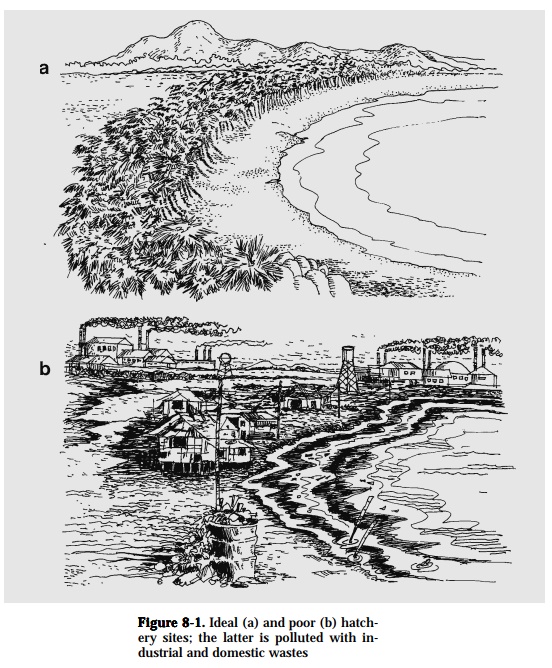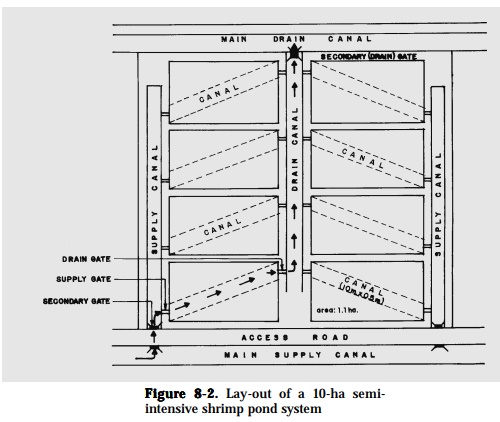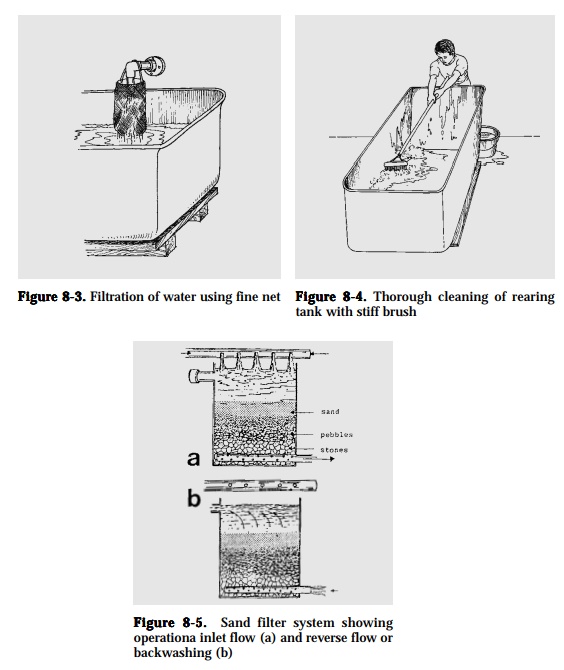Chapter: Health Management in Aquaculture: Physical, environmental, and chemical methods of disease prevention and control
Environmental methods of disease prevention and control in Aquaculture
ENVIRONMENTAL METHODS
Monitoring of the environment is extremely important for success in fish culture. The primary objective of the environmental method is to protect the host by intercepting the pathogen or cutting its pathway to the host. The sections that follow will attempt to describe some of the ways this is carried out.
Proper Hatchery/Pond Design
Trained personnel and well-designed hatcheries or ponds are importantrequirements in ensuring that fish health management practices can be incor-porated in the routine operations of an aquaculture system. The hatchery or farm should have access to a good water supply free from any type of pollution (Fig. 8-1). Pond development, wherever possible, should be adjacent to man-grove areas for protection from erosion, and to provide natural filter for farm effluent. Provision of independent water supply and drainage canals (Fig. 8-2) to each individual part of an aquaculture grow-out facility will ensure that water emerging from one pond compartment does not enter the other compart-ments. Fishponds should be kept free of wild fish and other potential carriers of infectious agents such as invertebrates, pests and predators. The farm/ hatchery should be accessible by road to avoid excessively long transport time of the larvae or fish.

Good Water Quality
Good water quality is crucial in the hatchery or pond; it can spell the difference between success and failure of the aquaculture enterprise. The lower the water quality, the fewer fish/shrimp it will support; the higher the water quality, the higher the production potential will be. Aside from being pathogen-free, the

water must meet the specific quality requirements of the cultured species. Monitor regularly the rearing water quality parameters such as salinity, pH, dissolved oxygen, ammonia and temperature. Ultraviolet radiation and filtra-tion systems eliminate potential pathogens. Sand filters or filter bags will re-move most of the debris.
Filter water with fine net (Fig. 8-3), cloth or cartridge filter before stocking in tanks. Clean filters regularly. Aerate and change rearing water regularly. Siphon off bottom sediments regularly to remove feces, organic debris and unused feed. Provide paddle wheels as aeration in ponds and a large settling reservoir to reduce the organic and particulate load before it is directed into ponds.
Sanitary Practices
Cleanliness improves the general standard of health. It also prevents or retardsthe development of disease agents. Drain and dry the tank (Fig. 8-4) and pond bottom in between culture periods. Backwash or clean filters regularly (Fig. 8-5). Day-to-day hygiene measures should include siphoning out of organic material that accumulate in tank bottom, immediate removal of any dead fish, and careful control of aquatic vegetation in ponds. Provide properly labeled gear like scoop nets, buckets and pails for exclusive use in individual facilities. Use PVC or non-toxic plastic pipes, pails and other equipment parts. Workers should disinfect their hands with soap and water before preparing and administering feed, and before performing other jobs.

Stress Avoidance
Stress plays a major role in the susceptibility of fish to disease. Most diseasesare stress-related. Poor water quality, inadequate food, overstocking, handling, grading, and transfer and transport of animals are stress inducing factors. Regular monitoring of the health status of the stock can detect early signs or onset of diseases before they become uncontrollable.
Quarantine Procedures Legislation :
Quarantine measures are very important for the prevention of the internationalspread of diseases of aquatic organisms. Legislations to impose quarantineprocedures on fish imported and exported requiring health certification of incoming fish into countries will minimize worldwide spread of fish patho gens. Sanitary classification of farms can be instituted such that exchanges offish occur only among farms of similar fish health status.
Quarantine should be practiced to minimize risk of disease among local species. Fish imported from abroad, or fish moved from one place to another within a country, should be placed in quarantine on arrival and should remain there until all danger has passed. The quarantine period should exceed the length of the longest latent period of the pathogens. Fish markets can become centers for the dispersal of pathogens. To avoid this danger, fish should be disinfected upon arrival at the market. The quarantine period for incoming stock must be observed for at least 2-3 weeks. Legislation of quarantine requirements should be imposed on all imported and exported fish to minimize the spread of disease, both within a country and outside. Quarantine ponds must be safely isolated and must be located downstream from all other ponds on the farms to minimize the danger of pathogen penetration.
Termination Procedures
Termination procedures may also be used to control fish diseases. Theseinclude destruction of infected individuals, by burning, cooking or burying in limed pits. Disposal of infected individuals should be to areas that will not affect the culture system. Avoid contact between diseased and normal indi-viduals. Disinfect the water supply system that may have carried the pathogen by draining and drying the affected tanks and ponds. Disinfect paraphernalia used on infected individuals.
Related Topics